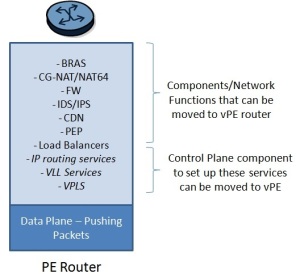Customer Premises Equipment (CPE) devices have always been a pain point for the service providers. One, they need to be installed in large large numbers (surely you remember the truck rolls that need to be sent out), and second, and more importantly, they get complex and costlier with time. As services and technology evolve, these need to be replaced with something more uglier and meaner than what existed before. In a large network, managing all the CPEs — right from the configuration, activation, monitoring, upgrading and efficiently adding more services – in itself becomes a full time job (and not the one with utmost satisfaction i must add).
ETSI’s Use case #2 describes how the CPE device can be virtualized. The idea is to replace the physical CPEs with all the services it supports on an industry standard server that is and cheaper and easier to manage. Doing this can reduce the number and complexity of the CPE devices that need to be installed at the customer sites.
The jury is still out on the specific functions that can be moved out of the CPE. Clearly, what everybody agrees to is a need for a device that will physically connect the customer to the network. There will hence always be a device at the customer premises. If we can virtualize most of the things that a CPE does, then this device could be a plain L2 switch that takes packets from the customers and pushes those towards the network side.
So what do we gain by CPE virtualization?
You reduce the number of devices deployed at customer premises. Most enterprise customers when adding new services add more devices beyond the access point/demarcation device or NID. If the functions serviced by those devices can be virtualized, then you dont need to add those extra devices.
In residential markets, we can completely remove the set-top boxes (including storage for video recorders) and the layer 3 functions provided by home gateways as these functions can be virtualized (on standard servers driven by highly scalable cloud-based software) , leaving each home with a plain L2 switch. This apparently is already underway as we speak.
Since each site has a vanilla L2 switch, you dont need to replace it till its potent enough to handle the incoming traffic onslaught. Since all the intelligence resides in the standard server, it can easily be replaced/upgraded without involving the dreaded truck rolls.
Your engineers dont have to visit customer premises for upgrades. Since most of the services are hosted over the cloud, all upgrades happen at the hosting location or the data center. Even if the virtualized services are deployed at the customer premises, you dont have to upgrade each CPE device. Its only the server at the customer premises that needs an upgrade.
Newer services and applications can be easily introduced, since those can be tested out at the hosting location or the data center. You dont have to worry about trying it out on all the different CPE devices. Barrier to entry in the network has suddenly lowered since the legacy CPE equipment doesnt need to be replaced. Also helps avoid vendor lock-in if all CPE devices are plain L2 switches and all the “work” is being done in SW on the standard servers.
Scaling up becomes less of a headache. BGP routers, as they start scaling, run out of control plane memory much before they hit the data plane limits. If the control plane has been virtualized, then its much easier to address this problem vis-a-vis when BGP is running on physical routers.
There are several vendors pushing for CPE virtualization. If you’re a CPE vendor who believes that your services are far too complex to be virtualized, then beware that things are moving very fast in the NFV space. I had earlier posted about how virtual routers can replace the existing harware here. Its fairly easy to imagine CPEs going virtual — from being high end devices to easily commoditized L2 switches! So if you dont evolve fast, then you run the risk of getting extinct!


